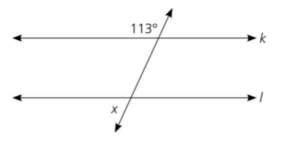
“If two lines in the same plane are cut by a transversal so that the sum of the measures of a pair of interior angles on the same side of the transversal is less than 180, the lines will meet on that side of the transversal” (Wang, 2021).
Any geometry which doesn’t meet this postulate is called non-Euclidean.
Origins of Euclidean Geometry
The origins of many geometric relationships like congruency and similarity can be traced back to the late stone age (Byer, 2010). Although many early works in the field were lost to history, one very significant text survived— Elements of Geometry by Euclid, which contains all the geometrical knowledge known at the time: 467 propositions on the geometry of planes and solids. Euclid’s Elements, as it came to be known, was the go-to text for over 2,000 years. It is only in recent years that other, non-Euclidean geometries have been discovered.
References
Byer, O. et al. (2010). Methods for Euclidean Geometry. The Mathematical Association of America. Wang, Y. (2021). Chapter 4: Euclidean Geometry. Retrieved January 4, 2021 from: http://www2.fairmontstate.edu/users/ywang/teaching/fsu/courses/geometry_372/lecture_372_ch4.pdf